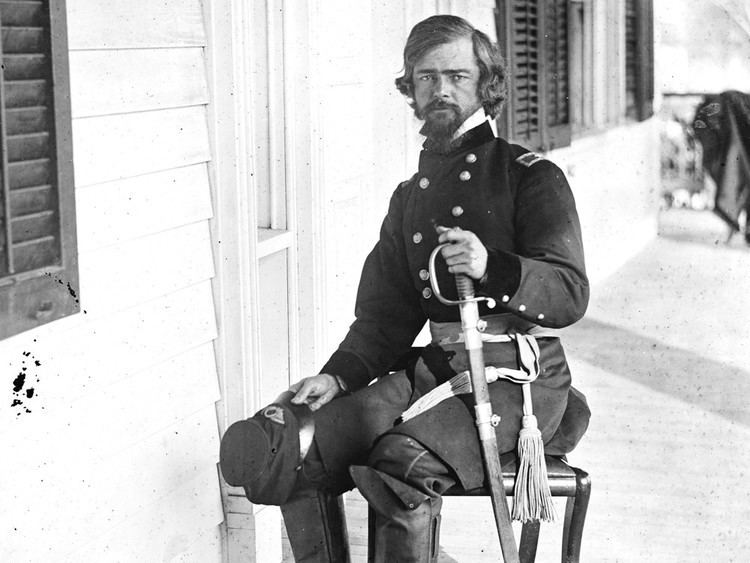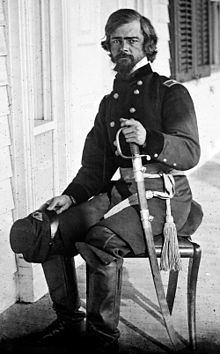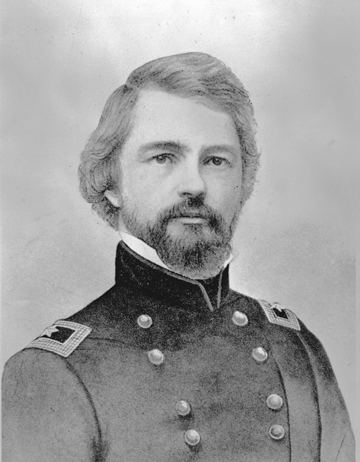Children Hazard Stevens Party Democratic Party | Role U.S. congressman Succeeded by LaFayette McMullen Name Isaac Stevens | |
 | ||
Born March 25, 1818North Andover, Massachusetts ( 1818-03-25 ) Books A true copy of the record of the official proceedings at the council in the Walla Walla Valley, 1855 Similar People Hazard Stevens, Philip Kearny, J E B Stuart, Stonewall Jackson, Abraham Lincoln | ||
Isaac Ingalls Stevens (March 25, 1818 – September 1, 1862) was the first Governor of Washington Territory, serving from 1853 to 1857. He was accredited as a founding member of the Territorial University of Washington, now known as the University of Washington today. He also served as a U.S. Congressman, and a Brigadier General in the Union Army during the American Civil War until his death at the Battle of Chantilly. He was appointed posthumously to the grade of Major General of volunteers.
Contents

Early life

Stevens was born and raised in Massachusetts, leaving his home state for the United States Military Academy at West Point in the late 1830s. He graduated in 1839, at the top of his class, and served for a number of years with the Army Corps of Engineers. He was promoted to first lieutenant in 1840.

Stevens was the adjutant of the Corps of Engineers during the Mexican-American War, seeing action at the siege of Vera Cruz and at Cerro Gordo, Contreras, and Churubusco. In the latter fight, he caught the attention of his superiors, who rewarded him with the brevet rank of captain. He was again cited and breveted for gallantry at the Battle of Chapultepec, this time to the rank of Major. He participated in combat at Molino del Rey, and the Battle for Mexico City, where he was severely wounded. He later wrote a book on his adventures, Campaigns of the Rio Grande and Mexico, with Notices of the Recent Work of Major Ripley (New York, 1851).

He superintended fortifications on the New England coast from 1841 until 1849. He was given command of the coast survey office in Washington, D.C., serving in that role until March 1853.
Governor (1853–1857)
A firm supporter of Franklin Pierce's candidacy for President of the United States in 1852, Stevens was rewarded by President Pierce on March 17, 1853 by being named governor of the newly created Washington Territory. (The position also included the title of Superintendent of Indian Affairs for that region). Stevens chose to add one more duty as he traveled west to the territory he would govern: the government was calling for a surveyor to map an appropriate railroad route across the northern United States. With Stevens' engineering experience (and likely the favor of Pierce yet again) he won the bid. His party, which included Dr. George Suckley, John Mullan and Fred Burr, son of David H. Burr, spent most of 1853 moving slowly across the prairie, surveying his way to Washington Territory. There he met George McClellan's party that had surveyed the line between the Puget Sound and the Spokane River. He took up his post at Olympia as governor in November that year.
As a result of his expedition, Stevens wrote a third book, Report of Explorations for a Route for the Pacific Railroad near the 47th and 49th Parallels of North Latitude, from St. Paul, Minnesota, to Puget Sound, (commissioned and published by the United States Congress) (2 vols., Washington, 1855–1860).
Stevens was a controversial governor in his time. Historians consider him even more controversial, for his role in compelling the Native American tribes of Washington Territory by intimidation and force to sign treaties that ceded most of their lands and rights to Stevens' government. These included the Treaty of Medicine Creek, Treaty of Hellgate, Treaty of Neah Bay, Treaty of Point Elliott, Point No Point Treaty, and Quinault Treaty. During this time, the Governor imposed martial law to better impose his will on the Indians and whites that opposed his views. The consequent political and legal battles would soon overshadow the Indian war. When Stevens was met with resistance, he used the troops at his disposal to exact vengeance.
His winter campaign against the Yakama tribe, led by Chief Kamiakin, and his execution of the Nisqually chieftain Leschi (for the crime of having killed Stevens' soldiers in open combat), among other deeds, led a number of powerful citizens in the territory to beg President Pierce to remove Stevens. Territorial Judge Edward Lander and Ezra Meeker (an influential private citizen) were both vocal in opposing Stevens—Lander was arrested as a result, and Meeker was simply ignored. Pierce sent word to Stevens of his disapproval of the governor's conduct, but refused to remove his appointee. Opponents of Stevens ultimately lost public support, as the majority of the citizens of Washington Territory considered the governor to be on the side of white settlers and Meeker to be overly concerned with the "Indians".
As a result of this public perception, Stevens was popular enough to be elected the territory's delegate to the United States Congress in 1857 and 1858. The tensions between the whites and the Native Americans would be left for others to resolve—Stevens is often charged with responsibility for the later conflicts in eastern Washington and Idaho, especially the war fought by the United States against Chief Joseph and the Nez Perce, but these events were decades away when Isaac Stevens left Washington State for good in 1857.
Martial Law
In April 1856, Governor Stevens removed settlers whom he believed to be aiding the enemy and placing them in the military's custody. Governor Stevens then declared martial law in Pierce County to ensure a military trial for those settlers. A declaration of martial law for Thurston County would soon follow. Nonetheless, only the territorial legislature possessed the authority to declare martial law, and a bitter political and legal battle ensued. Stevens would be forced to repeal the declaration and fight subsequent calls for his removal. Steven's decision to use martial law was the result of his determination to enforce a blockhouse policy in the war against the Indians of the Puget Sound region. Indian raids on scattered settlements and an intimidating attack on the city of Seattle in February 1856 resulted in Governor Stevens considering that defensive measures would be significantly more effective with the limited number of men at his disposal; the white population should be concentrated at specific strongly protected points. For that reason, the volunteers under Stevens command built a series of forts and blockhouses along the Snoqualmie, the White, and the Nisqually rivers. Once completed, Stevens ordered the settler population to leave their claims and take temporary residence in these safer areas.
Once Stevens proclaimed martial law, he raised a new and more significant issue. Stevens' proclamation of martial law in Pierce County stated:
"Whereas in the prosecution of the Indian war circumstances have existed affording such grave cause of suspicion, such that certain evil disposed persons of Pierce county have given aid and comfort to the enemy, as that they have been placed under arrest and ordered to be tried by a military commission; and whereas, efforts are now being made to withdraw, by civil process, these persons from the purview of the said commission. Therefore, as the war is now being actively prosecuted through- out nearly the whole of the said county, and great injury to the public, and the plans of the campaign be frustrated, if the alleged designs of these persons be not arrested, I, Isaac I. Stevens, Governor of the Territory of Washington, do hereby proclaim Martial Law over the said county of Pierce, and do by these presents suspend for the time being and till further notice, the functions of all civil officers in said county."
On May 11, 1856, attorneys George Gibbs and H. A. Goldsborough sent a letter to the Secretary of State denying that the war situation throughout the territory and especially in Pierce County was as grave as Governor Stevens had declared at the time of proclaiming martial law. They ascertained that the allegations made against Charles Wren, John McLeod, John McField, Lyon A. Smith, and Henry Smith, were based wholly on suspicion and that the only factual evidence was that on Christmas Day a party of Indians had visited McLeod's cabin and had forced him to give them food. Gibbs and Goldsborough declared that:
"The sole object of the proclamation was to get half a dozen obscure individuals into his absolute control, and to demonstrate that he, Isaac I. Stevens, could, on the field offered by a small Territory, enact, at second hand, the part of Napoleon."
The territorial organic act designated the governor as “commander-in-chief of the militia thereof” but there were not a regularly constituted militia in existence. Stevens assumed his powers from his control of local volunteer troops which had been organized to meet the necessities of the situation, but had not been authorized either by the federal government or by the territorial legislature. Stevens position as Superintendent of Indian Affairs for the territory had a broad administrative responsibility but possessed no direct military power to go with it. On May 24, 1856, following a legal opinion rendered by Judge Chenoweth regarding his legal position that he had no legal power to declare martial law, Governor Stevens rescinded his proclamation in Pierce and Thurston counties.
Civil War
After the Civil War began in 1861, and following the Union defeat at the First Battle of Bull Run, Stevens was commissioned in the Army again. He was appointed as Colonel of the 79th New York Volunteers, known as the "Cameron Highlanders." He became a brigadier general on September 28, 1861, and fought at Port Royal. He led the Second Brigade of the Expeditionary Forces sent to attack the Sea Islands off the coast of South Carolina. He led a division at the Battle of Secessionville, where he personally led an attack on Fort Lamar in which 25% of his men were casualties.
Stevens was transferred with his IX Corps division to Virginia to serve under Major General John Pope in the Northern Virginia Campaign and the Second Battle of Bull Run. He was killed in action at the Battle of Chantilly on September 1, 1862 after picking up the fallen regimental colors of his old regiment, shouting "Highlanders, my Highlanders, follow your general!" Charging with his troops while carrying the banner of Saint Andrew's Cross, Stevens was struck in the temple by a bullet and died instantly.
He was buried in Newport, Rhode Island at Island Cemetery. In March 1863, he was posthumously promoted to major general, backdated to July 18, 1862.
Hazard Stevens, Isaac's son, was also injured in the Battle of Chantilly. He rose to become a general in the U.S. Army and an author. Together with P. B. Van Trump, he participated in the first documented ascent of Mount Rainier.
Memorialization
But, Stevens Pass in the Cascade Mountains of Washington on US Highway 2 is named after John Frank Stevens (no relation), a locating engineer for the Great Northern Railway.
